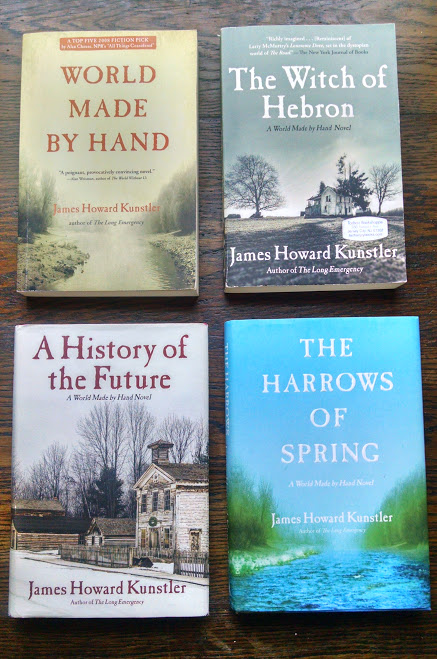A New Life in Union Grove: Thoughts on the World Made By Hand Series
The Harrows of Spring concludes an eight-year fictional odyssey for author James Howard Kunstler. His four-volume World Made by Hand series began in 2008 with the novel by the same name. Each novel is set during a season within a single year. The series opens in the summer and now closes with spring, a time of new beginnings, arriving to the fictional town of Union Grove, New York. How will renewal appear and affect the small world of this Upstate New York hamlet?
World Made by Hand depicts a new landscape and world emerging from that of the old. The series is set at an indeterminate point in the very near future. The United States has suffered through warfare, terrorist attacks, localized nuclear assaults, pandemics, and a complete collapse of the power grid, energy infrastructure, and economy. Any semblance of a working military and government has withered away. Amazingly, society and civilization carries on and adapts to the difficult, if not brutal changes besetting them.

World Made by Hand novels: (clockwise) World Made by Hand; The Witch of Hebron; A History of the Future; The Harrows of Spring (Photograph by author).
Before delving further into the series, one point must be clear: World Made by Hand is not a dystopic work. Yes, society as we understand it is dead and gone. After the dust settles from the disaster and disorder, people accept the changes and begin adjusting to the new realities. They begin to rebuild their pocket of the world to meet the new challenges and to make the most of this new life.
The four novels center upon a cast of characters inhabiting Union Grove, a small town near the Battenkill River and within the sphere of current-day Albany, New York. Characters shift from major to minor to peripheral and back again through the course of the series. World Made By Hand is from the first-person point of view of Robert Earle, the town carpenter and mayor. The following three novels incorporate multiple third-person points of view, allowing the reader to experience a more complex and layered understanding of Union Grove and the world beyond its boundaries.
In Union Grove, the residents carve out a thriving existence in the new hard times, which resembles a hybrid of homesteading fantasies and homespun (Northern) antebellum America as captured in literature and paintings. Most people work with their hands, occupied by agriculture, carpentry, and other handicrafts, such as shoe making or leather working. Without electricity, people’s daily routines parallel the rising and falling of the sun. Still, culture and civilization persist. The town maintains a one-room schoolhouse. The Congregational Church celebrates each Sunday. The local library lends books. The village librarian also serves as the local portraitist. Musicians entertain at soirees and festivals. Throughout the four novels, the people of Union Grove experience loss, fall in love, suffer failure, and survive danger. They live life. This new world appears to be full of hope and possibility and somewhat better than our own.
Overall, the series offers an absorbing, speedy narrative sprinkled with memorable scenes and evocative language. In particular, Kunstler creates a vibrant, almost tangible fictional landscape, especially when describing the food, weather, and nature of his new world. One can feel the crisp coolness of a late autumn afternoon, hear the soothing trickle of a forest stream, or smell meat slowly roasting over an open fire.
The series is not without its shortcomings. Periodically, Kunstler illustrates the ever-present danger of this new world: a child dies due to the absence of a simple vaccine; travelers are waylaid by roadside bandits; or a woman is mauled by bear while foraging for herbs. Contemporary given luxuries, such as antibiotics, running water, and communications, no longer exist. However, an idealism and joyous wonder for this fictional new world imbues the entire narrative, glossing over the pain and death accompanying the loss of modernity, science, and technology.
In the novels, the citizens of Union Grove live good, decent lives. Although characters mention nuclear fallout in Washington, D.C. or an exotic flu strain that wiped out swathes of the population, Union Grove seems to have been spared the worst and seems to be isolated from the ugliness and despair following the downfall of the United States (and presumably every national) government. Possibly, Kunstler is trying to make the point that not everyone and everyplace is fully and equally impacted by events and history.
Structurally, the four novels are uneven. The first novel, World Made By Hand, and the second, The Witch of Hebron, are great reads. As a lover of autumn, The Witch of Hebron is my favorite in the series. Unfortunately, the following two, A History of the Future and The Harrows of Spring, do not feel fully fleshed out. One wonders if Kunstler was rushing to meet contractual deadlines or simply wished to move onto a new project. Nonetheless, all four are original and enjoyable books and form a coherent whole.
Fundamentally, The World Made By Hand series asks readers to reengage with the world. How to see wonder and magic in it each and every day? After losing the trappings, distractions, and pressures of modernity, the protagonists of World Made By Hand discover their core humanity and their true purpose. James Howard Kunstler presents this challenge to readers with his fiction. Are we up to it?